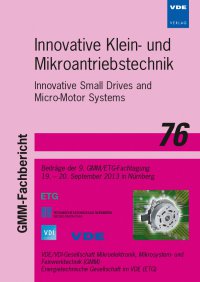Design of a Fully Actuated Electromagnetic Bending Actuator for Endoscopic Applications
Conference: Innovative Small Drives and Micro-Motor Systems - 9. GMM/ETG-Fachtagung
09/19/2013 - 09/20/2013 at Nürnberg, Deutschland
Proceedings: Innovative Small Drives and Micro-Motor Systems
Pages: 6Language: englishTyp: PDF
Personal VDE Members are entitled to a 10% discount on this title
Authors:
Woehrmann, M.; Doerbaum, M.; Ponick, B.; Mertens, A. (Institute for Drive Systems and Power Electronics, Leibniz Universität Hannover, Hannover, Germany)
Abstract:
This article presents a novel concept for a fully actuated electromagnetic bending actuator for endoscopic applications, resembling a snake in appearance and in flexibility. Flexibility is reached by a clever arrangement of the individual a ctuator elements, each being tiltable by a defined angle. This tilting is realised by electromagnetism, and each element is able to take discrete angular positions. The different positions in workspace are reached by correspondingly controlling the individual elements within the actuator. In a first step, the operating principle and different types of actuators are described. Compared to rotary machines which can often be calculated by two-dimensional models, this actuator requires a three-dimensional calculation approach. The calculation can either be realised analytically, by a magnetic ne twork or numerically based on the Finite Element method. In this article, the numerical approach via the FEM software Maxwell is used. In doing so, different types of actuators are calculated and compared with each other. The calculated maps show a strong nonlinear dependence of the actuator torque on the angular pos ition as well as on the electrical excitation. In open state, the actuator torque is very small. When closed, it increases up to three powers of ten. On the one hand, the magnetic circuit and thus the actuator design must be optimised with respect to higher actuator torques when open. On the other hand, high electrical excitation is required to rotate the actuator, whereas maintaining the actuator in its closed state just requires a small electrical excitation.


